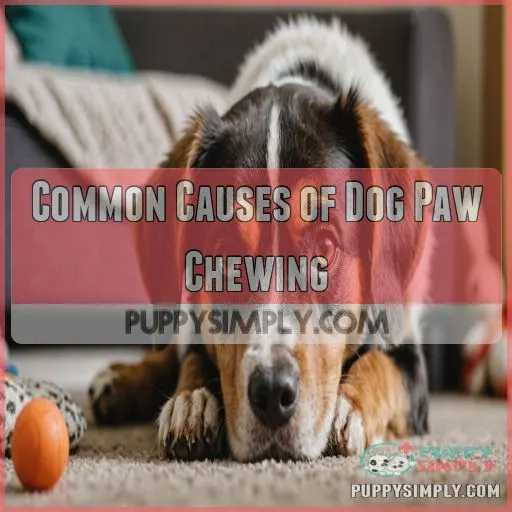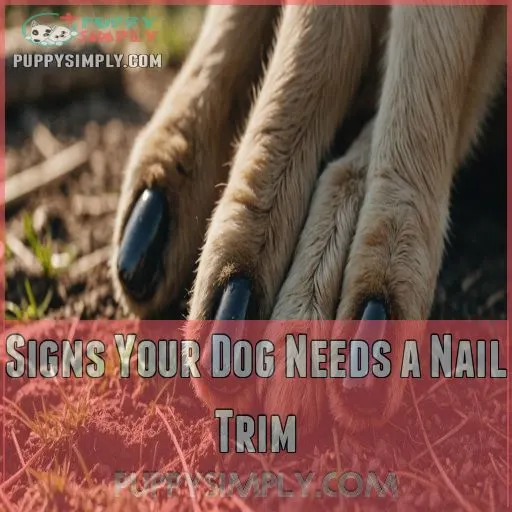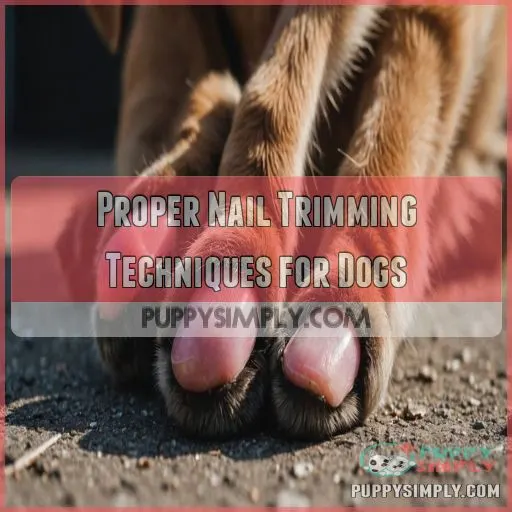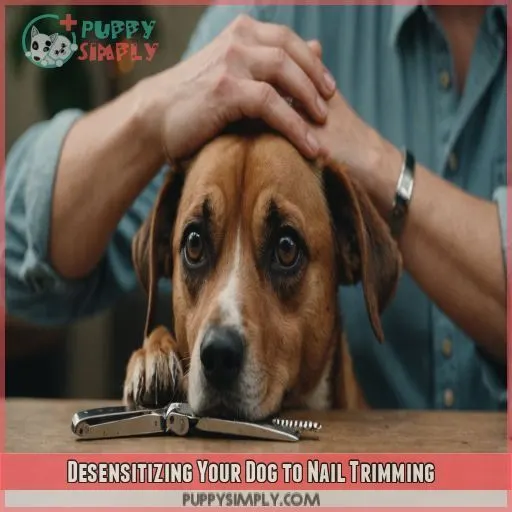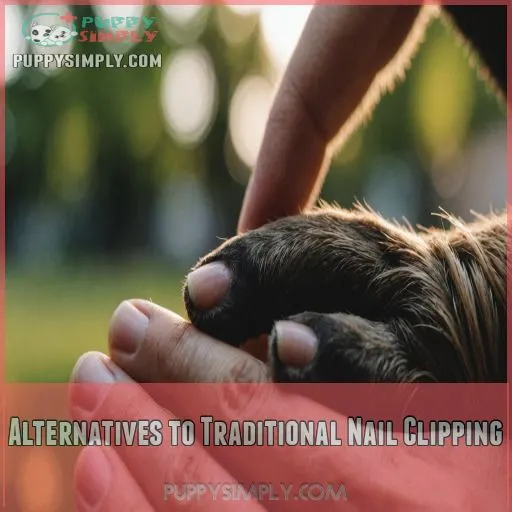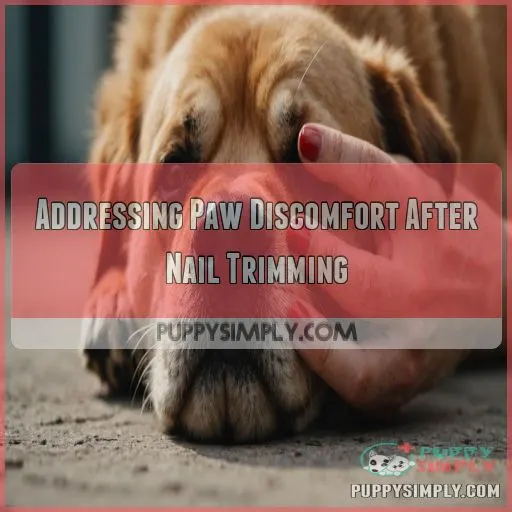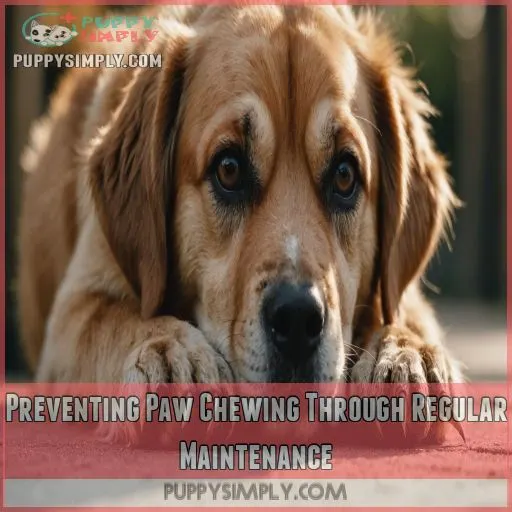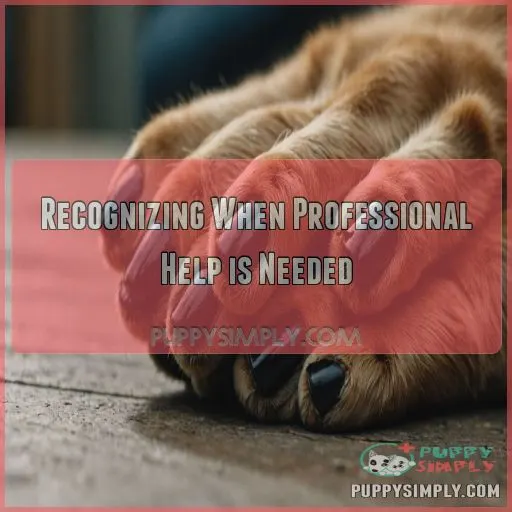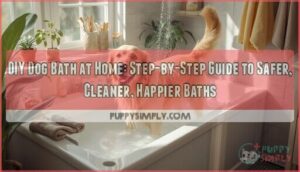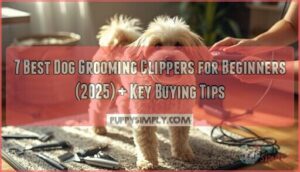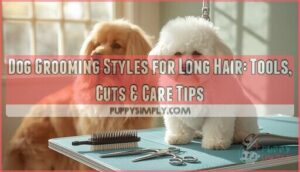This site is supported by our readers. We may earn a commission, at no cost to you, if you purchase through links.
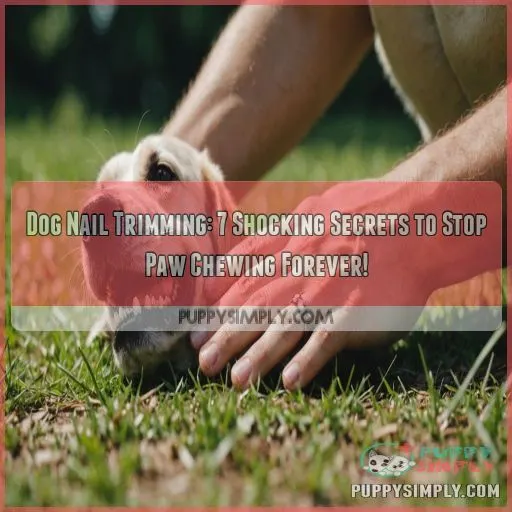 Trimming your dog’s nails can be the secret sauce to stopping that pesky paw chewing. Long nails can make walking uncomfortable, kind of like trying to dance in shoes two sizes too big.
Trimming your dog’s nails can be the secret sauce to stopping that pesky paw chewing. Long nails can make walking uncomfortable, kind of like trying to dance in shoes two sizes too big.
Regular trims help your dog’s comfort, help improve balance, and reduce anxiety-induced chewing. Use high-quality clippers or grinders for the best results—treats and praise work wonders for cooperation! Check for a clicking sound on floors as a reminder.
Remember, nail trimming isn’t just a task; it’s an act of love. Curious about mastering the art without the fuss? That’s just the tip of the iceberg…
Table Of Contents
- Key Takeaways
- Common Causes of Dog Paw Chewing
- Signs Your Dog Needs a Nail Trim
- Proper Nail Trimming Techniques for Dogs
- Desensitizing Your Dog to Nail Trimming
- Alternatives to Traditional Nail Clipping
- Addressing Paw Discomfort After Nail Trimming
- Preventing Paw Chewing Through Regular Maintenance
- Recognizing When Professional Help is Needed
- Frequently Asked Questions (FAQs)
- How do I stop my dog from chewing his paws?
- How do I get my dog to stop biting when I cut his nails?
- What can I give my dog to sleep so I can cut his nails?
- Why is my dog chewing his paws after grooming?
- How often should I trim my dogs nails?
- What are the signs of overgrown nails in dogs?
- Can I use human nail clippers on my dog?
- How do I desensitize my dog to nail trimming?
- When should I seek professional help for nail care?
- Conclusion
Key Takeaways
- Regular nail trims can stop your dog from feeling like they’re tap-dancing in stiletto heels. Keep an ear out for clicking sounds on hard floors—that’s your signal it’s time for a trim.
- Nail trimming isn’t just a task; it’s an act of love. It helps prevent discomfort and encourages a happier, chew-free pup. Visualize those long nails as toothpicks poking with every step, and snip them away.
- Use high-quality tools designed for canine claws, not your kitchen scissors. Imagine sculpting a clay masterpiece – not too much pressure – and you’ll avoid the quick and keep your dog’s paws happy.
- Desensitizing your pup with treats, praise, and gentle handling turns nail trimming from dread to delight. Picture it like dance rehearsals: practice makes perfect, and both of you will be in sync in no time.
Common Causes of Dog Paw Chewing
You’ve caught your furry friend obsessively chewing their paws, and you’re wondering what’s up.
Understanding the common causes of this behavior is the first step to helping your pup find relief and stopping the chew-fest for good.
Allergies and Environmental Irritants
Your furry friend’s paw-chewing habit might be more than just a quirk – it could be a cry for help! Allergies and environmental irritants are often the culprits behind this pesky behavior.
From pollen to household cleaners, your pup’s world is full of potential triggers.
By identifying common allergens and improving indoor air quality, you’ll be one step closer to soothing those itchy paws and stopping the chew-fest for good.
Parasites and Infections
Countless tiny invaders could be wreaking havoc on your pup’s paws. Fleas, ticks, and mites aren’t just pesky hitchhikers; they’re potential paw-chewing culprits.
But don’t forget about sneaky bacterial and yeast infections. These microscopic troublemakers can turn your dog’s feet into an itchy battleground.
Regular flea treatments and tick prevention are your first line of defense. If you spot excessive licking or redness, it’s time for a vet check-up to rule out skin allergies or other infections.
Anxiety and Boredom
While parasites can cause paw troubles, anxiety and boredom are often overlooked culprits. Dogs are like kids – they need mental and physical stimulation to stay out of mischief. When they’re feeling stressed or have nothing to do, they might turn to paw chewing for relief or entertainment.
Here are 4 ways to keep your pup’s mind and body engaged:
- Puzzle toys for mental gymnastics
- Daily walks and play sessions
- Training exercises to bond and learn
- Interactive feeders for mealtime fun
Pain or Discomfort From Overgrown Nails
Overgrown nails aren’t just a fashion faux paw – they’re a real pain for your furry friend!
Long nails can twist toes, causing discomfort with every step.
Think of it like walking in shoes two sizes too small.
This constant ache can lead to joint pain and even alter your pup’s gait.
Different breeds have varying nail growth rates, so regular checks are key to keeping your dog’s tootsies in tip-top shape.
Dry or Cracked Paw Pads
Your pup’s paws aren’t just for walking—they’re sensitive, complex structures that need TLC. Dry or cracked paw pads can be a real pain, causing your furry friend to lick and chew incessantly.
Here’s the lowdown on keeping those paws in tip-top shape:
- Moisturize daily with a paw pad balm
- Protect paws from harsh surfaces
- Clean and dry paws after walks
- Establish a regular paw care routine
Don’t let your dog’s paws become a source of discomfort!
Signs Your Dog Needs a Nail Trim
Is your furry friend constantly nibbling on their paws? You might be surprised to learn that overgrown nails could be the culprit behind this pesky habit.
Visible Nail Length and Shape
At a glance, you can spot if your pup’s nails need a trim. Look for nails that curve over the pad or touch the ground when standing.
As nails grow, they’ll start to resemble tiny hooks or claws. This unnatural shape can cause discomfort and affect your dog’s gait.
Regular checks will help you stay on top of nail growth and determine the ideal trim frequency for your furry friend.
Clicking Sounds on Hard Surfaces
Imagine tap shoes as your dog tiptoes across the hard floor; those clicking nails are a cry for a trim. Address nail clicking to reduce sound and enhance paw health.
Here’s a quick guide:
- Listen for clicking on floors.
- Observe any paw chewing.
- Trim nails regularly to control dog behavior and improve dog care.
Changes in Gait or Posture
Noticing changes in your dog’s gait or posture could be a sign their nails need trimming.
If they’re walking with a limp, shuffling their feet, or seem uncomfortable, it may indicate their nails have grown too long.
This can put strain on their joints and muscles, leading to pain and discomfort.
Pay close attention to their movements and address any changes promptly.
Difficulty Walking or Standing
Spotting changes or limping may indicate overgrown nails making your dog feel arthritis-like discomfort.
Imagine trying to hike in clown shoes.
Nails disrupt balance, causing muscle weakness and joint pain, leading to neurological problems or paw pad issues.
Trimming those nails helps your pup regain their swagger, ensuring a safe, pain-free stride.
Increased Paw Licking or Chewing
Paw licking can be like a dog’s way of waving a red flag.
Commonly, it’s a sign their nails are too long, or they’re stressed.
Keep an eye out for:
- Nail Length: If they’re tapping away on the floor.
- Stress Reactions: Increased licking after stressful events.
- Other Causes: Consider underlying health issues or allergies.
Proper Nail Trimming Techniques for Dogs
Trimming your dog’s nails can seem like a tough task, but with the right approach, it doesn’t have to be a nail-biting experience—literally, especially if you find a vet specializing in nail trims!
By mastering proper techniques, such as selecting the right tools and learning how to identify the quick, you’ll keep those paws happy and chew-free.
Choosing the Right Tools
Choosing the right nail trimming tools is important for your pup’s comfort and safety.
Opt for high-quality, sharp clippers or a grinder designed specifically for dogs.
Make sure the size fits your canine’s nails snugly – no one likes a loose tool!
With the right gear, you’ll be a nail-trimming pro in no time.
Identifying the Quick
Let’s put the spotlight on spotting the quick—the sensitive part inside your dog’s nail that you want to avoid.
The quick’s anatomy can differ, but look for the change in color and shape.
It’s more visible in lighter nails, but for darker ones, quick trimming is a careful guessing game.
Never hesitate; your dog’s comfort is in your hands.
Correct Angle and Pressure for Cutting
You’ve spotted the quick, now find the perfect angle – a 45-degree tilt.
Apply gentle pressure, not enough to trigger bleeding but just right to shape the nail. Think of it as slicing through bread without squashing it.
Your dog will thank you by not chewing those paws, making their walk in the park smooth as butter.
Dealing With Dark Nails
Trimming dark nails can be like finding the light at the end of the tunnel. Use a flashlight to see the nail quick better. If you hit it, stay calm; it’s no catastrophe.
- Trim tiny bits until you see a change in nail texture.
- Keep styptic powder nearby for emergencies.
- Use a DIY nail grinder for smoother edges.
Frequency of Nail Trims
There’s no one-size-fits-all rule for how often to trim your pup’s nails.
It really depends on factors like their breed, activity level, and the surfaces they walk on.
As a general guideline, check their nails weekly and trim them when they start clicking on hard floors.
Staying on top of regular nail trimming helps keep your dog comfortable and prevents painful overgrowth.
| Breed | Activity Level | Surface Type | Trim Frequency |
|---|---|---|---|
| Small/Toy | Low | Soft | 4-6 weeks |
| Medium | Moderate | Mixed | 6-8 weeks |
| Large/Giant | High | Hard | 2-4 weeks |
Desensitizing Your Dog to Nail Trimming
Desensitizing your dog to nail trimming might sound like a Herculean task, but with a little patience, it’s as easy as teaching Rover to sit and learn the basics of nail anatomy.
By consistently using treats and praise, you’ll turn nail trimming from a battle into a breeze!
Positive Reinforcement Techniques
Imagine your furry friend as a nail trimming pro, all thanks to the power of positive reinforcement! Use treats, praise, and clicker training as your secret weapons.
Consistency and patience aren’t just buzzwords— they’re your trusty sidekicks.
Celebrating small victories transforms nail time from a dreaded chore into a wag-worthy experience, making your pup’s paws feel renewed and cozy.
Gradual Exposure to Tools and Handling
Desensitize your dog with gradual exposure to nail trimming tools and handling, using high-quality dog nail clippers.
You can use these tricks:
- Offer praise when your pup shows interest in clippers.
- Gently rub their paws during cuddle time using soothing voices.
- Introduce clippers as a positive accessory.
- Keep initial sessions short and sweet, just like a tiny treat!
Creating a Calm Environment
Creating a calm, soothing environment is key when desensitizing your pup to nail trims.
Dim the lights, play some calming music, and make sure they’ve a cozy, comfortable space.
This helps them feel safe and relaxed, making the process much smoother.
Stay patient and use positive reinforcement – your dog will thank you!
Using Treats and Praise Effectively
Setting a calm environment works wonders, but let’s sweeten the deal. Treat timing and reward value can build a positive association with nail trimming.
Here are some tips:
- Use high-value, tasty treats.
- Offer treats immediately after each nail trim.
- Mix in some verbal praise variety.
- Experiment with treat alternatives like toys or belly rubs.
Consistency in Training Sessions
Think of training like brushing your teeth—short, consistent sessions win the race!
Stick to a routine schedule, ensuring you practice with patience and frequency.
Integration of rewards and positive reinforcement is your not-so-secret weapon.
Dogs love predictability, so make each session fun, not a chore.
Consistency is key—your dog will thank you with well-behaved paws!
Alternatives to Traditional Nail Clipping
Don’t let nail trimming stress you out when there are easy alternatives that can save both you and your pup from the drama.
From the gentle hum of nail grinding tools to the protective charm of nail caps, these options might just be the paw-some solution you’ve been searching for!
Nail Grinding Tools
If your dog dreads nail trims, nail grinders may be a game-changer.
These power tools gently file down nails without the sharp snip of clippers.
Consider these 4 key benefits: 1) Less stress for your pup, 2) Precise control over nail length, 3) Ideal for dark nails, 4) Gradual conditioning for puppies.
Give it a try – your dog will thank you!
Professional Grooming Services
When it comes to dog grooming, leaving nail trims to the pros might just save your sanity.
With groomer training ensuring safe clips, and mobile groomers bringing their kit to your door, it’s a convenient option.
Check groomer reviews for reliability, since your pup deserves the best.
Grooming costs can vary, but peace of mind? Priceless!
Natural Nail Wear Through Exercise
Think of your dog’s walks as a fashion runway for their nails!
Exercise, especially on hard surfaces, naturally wears down nails.
Various breeds and exercise types affect nail wear rates.
Running on concrete is like a nail file for your pup—just remember not to overdo it.
Keep their paws healthy and stylish with regular adventures.
Nail Caps and Protective Booties
Nail caps and protective booties can be game changers for your pup’s paw health! They keep claws cushioned and safe, putting an end to destructive chewing.
- Explore different nail cap types for the right fit.
- Check boot sizes for comfort.
- Opt for boot durability against rough terrains.
- Prioritize paw protection with these nifty tools.
- Compare costs for budget-friendly options.
Consider this your secret weapon for happy paws!
Paw Balms and Moisturizers
Alongside nail trims, paw balms and moisturizers can be a game-changer for your pup’s happy feet.
Look for natural ingredients like shea butter, coconut oil, and beeswax to soothe dry, cracked paws.
Apply a thin layer after walks or baths, and consider making your own DIY balm for a personalized touch.
Your dog will thank you!
Addressing Paw Discomfort After Nail Trimming
You’ve tackled nail trimming like a pro, but what happens when your furry friend starts gnawing at those freshly clipped claws?
It’s time to address paw discomfort with quick tips that soothe irritated pads and keep tails wagging!
Inspecting for Cuts or Bleeding
In a world of nail trimming, sometimes we nick a little close.
Inspect for any bleeding or paw wounds with first aid skills that’d make your grandma proud.
Spot blood? Act swiftly with home care measures.
Got concerns? A vet visit might be in order.
Applying Styptic Powder for Minor Injuries
You’ve accidentally trimmed a bit too much, and now there’s minor bleeding. Calm yourself—these things happen.
Grab some styptic powder and gently dab it on the cut.
Like a magical cure, it stops the bleed and your pup feels better in no time.
Monitoring for Signs of Infection
After trimming your pup’s nails, keep a close eye out for any signs of infection, like redness, swelling, or discharge around the paws.
If you notice your dog favoring a paw or limping, it could indicate pain or discomfort.
Don’t hesitate to consult your vet if you have any concerns – your furry friend’s wellbeing is top priority.
Soothing Irritated Paw Pads
You know, soothing irritated paw pads can feel like a spa day for pups!
Try these natural remedies:
- Paw pad balm: Moisturizes and heals with a touch of coconut oil.
- Oatmeal baths: Relieves itchiness and calms inflamed pads.
- Ice packs: Reduce swelling and bring quick relief.
Keep your dog comfy with these handy helpers!
When to Seek Veterinary Care
If soothing irritated paw pads doesn’t do the trick, it might be time to call in the cavalry—your vet, of course. Persistent paw chewing, licking, or limping after a nail trim could mean there’s more than meets the eye. Watch for signs like nail bleeding or infection.
Trust your gut; when in doubt, a vet visit offers peace of mind.
Preventing Paw Chewing Through Regular Maintenance
You can keep your furry friend from chewing their paws with some regular maintenance that’ll make both of you happier.
From inspecting those cute little paws daily to ensuring they’re clean and dry after a romp through the park, a bit of routine care can prevent discomfort and keep your pup’s paws in tip-top shape!
Establishing a Grooming Routine
Establishing a consistent grooming routine is key to preventing paw chewing.
Bathe your pup regularly, brush their coat weekly, and trim nails every 4-6 weeks.
Don’t forget to clean their ears and brush their teeth too – your dog will thank you with a wagging tail!
Make grooming a bonding experience by using positive reinforcement.
Daily Paw Inspections
Found your groove in establishing a grooming routine? Fantastic! Let’s focus on daily paw inspections.
Consider it a key detective mission for paw pad health. Look for paw injuries, paw dryness, or debris like the world’s tiniest puzzles.
It’s about paw care routine mastery, ensuring paw hygiene shines bright and your dog struts safely and confidently, one paw at a time!
Cleaning and Drying Paws After Walks
Want your pup’s paws to feel pampered? Mud loves to hitch a ride home, so grab a towel for paw drying after walks.
The right drying methods and a dollop of paw balm keep nasties at bay.
Make it fun! Use booties for paw protection in messy weather. You’ll both breathe easy, trust in that.
Addressing Underlying Health Issues
Address underlying health issues that may cause paw chewing. Like a detective sniffing out clues, watch for:
- Skin allergies or fungal infections: They can cause persistent itchiness.
- Anal gland discomfort: Subtle yet irritating.
- Nail problems: Painful when left unchecked.
- Dental issues: Be vigilant; they can lead to stress and paw biting. Make a vet your trusty sidekick.
Providing Mental and Physical Stimulation
By providing ample mental and physical stimulation, you can curb your pup’s paw-chewing habit.
Engage their curious minds with interactive toys, puzzle feeders, and scent work.
Burn off excess energy through daily walks, dog park playdates, and even agility courses – your canine companion will be too busy having fun to worry about those pesky paws!
Recognizing When Professional Help is Needed
Knowing when to call in the professionals can make all the difference in tackling persistent paw chewing.
If your dog’s chewing habit lingers despite your best efforts or you’re dealing with snippy behavior during nail trims, it might be time to let the experts lend a paw.
Persistent Paw Chewing Despite Home Care
You’ve tried everything—keeping a solid grooming schedule, protecting those adorable paws, and tackling behavioral triggers with patience.
Yet your dog’s still chewing away like a nervous teenager with bubble gum.
Could underlying medical conditions or dietary needs be at play?
Imagine discovering that solving the mystery requires a vet’s expertise.
Trust us, sometimes even your pooch needs a doctor’s visit!
Signs of Severe Anxiety or Aggression
Dogs can show anxiety with signs as clear as day. Watch for:
- Body Language: Tucked tail, trembling, or wide eyes.
- Vocalization: Whimpering, growling, or barking.
- Destructive Behavior: Chewing furniture like it’s their nemesis.
- Escape Attempts: Bolting as if Houdini himself trained them.
Recognizing these can save your furniture—and your sanity! If needed, consult a vet.
Difficulty Trimming Nails Safely at Home
If you’re struggling to trim your pup’s nails at home, don’t worry – you’re not alone.
Some dogs get downright nervous around nail clippers, making the process a real challenge.
Rather than risk cutting the quick or causing your furry friend distress, it’s often best to enlist the help of a professional groomer or vet.
Suspected Infections or Injuries
Ever wonder whether your dog’s paw chewing signals a bigger problem? Spotting signs of infection or injury can be a real nail-biter!
Watch for:
- Redness or swelling
- Discharge that’s not going away
- Persistent limping or favoring a paw
- Excessive licking or chewing at one spot
- Refusal to walk normally
Acting quickly helps Fido’s paws stay in tip-top shape!
Breed-specific Nail and Paw Concerns
Figuring out breed-specific nail growth can feel like dancing on thin ice, especially when dewclaw issues rear their ugly heads.
Each breed boasts unique paw pad thickness and nail shape variations.
Embrace those quirky breed-specific grooming needs with humor—think of trimming a Great Dane vs. a Poodle!
When in doubt, seek professional help to make sure your pup’s paws stay pain-free.
Frequently Asked Questions (FAQs)
How do I stop my dog from chewing his paws?
Keep paws in check by ensuring they’re clean, moisturized, and nails trimmed.
Distract with toys if paws become a chew toy.
Persistent chewing? It might be an allergy or anxiety—time to chat with the vet.
How do I get my dog to stop biting when I cut his nails?
What can I give my dog to sleep so I can cut his nails?
When your dog’s fussing like a squirrel at a nut buffet, try calming treats or consult your vet about mild sedatives.
Trimming nails safely can be a game-changer for both of you!
Why is my dog chewing his paws after grooming?
Your dog may be chewing their paws after grooming due to irritation or anxiety.
Try soothing them with calming treats, a gentle massage, and patience – they’ll soon be back to their happy, healthy self.
How often should I trim my dogs nails?
Make claw-sharpening a walk in the park for your pup!
Aim for nail trims every 3-4 weeks—keep those tap-dancing paws from becoming talons.
Watch for clicking sounds on floors—they’re like a doggy percussion warning!
What are the signs of overgrown nails in dogs?
Overgrown dog nails click-clack on floors like high heels, make walking awkward, and might turn paws into tiptoed ballerinas.
Look for nails touching the ground, curving under, or splaying toes.
Trim time’s calling—it’s health, not just aesthetics!
Can I use human nail clippers on my dog?
Think you can wield human nail clippers on a dog? You’d have better luck herding cats!
Use dog-specific clippers to avoid injury.
They’re designed for thicker nails, ensuring safety and comfort for you and your furry friend.
How do I desensitize my dog to nail trimming?
Gradually accustom your pup to nail trims by making it a positive experience.
Start by letting them sniff the clippers, then reward with treats.
Slowly work up to touching their paws and trimming a nail or two at a time.
Patience and consistency are key!
When should I seek professional help for nail care?
You should seek professional help for nail care if your dog is anxious, aggressive, or if you’re just not comfortable doing it yourself.
It’s better to be safe than sorry and avoid potential mishaps (Source).
Conclusion
Imagine nail trimming as a superpower, giving your dog a new ‘leash’ on life by preventing paw chewing and discomfort.
Use these dog nail trimming tips to become the hero your pet deserves.
From selecting tools to regular maintenance, you’re equipped to keep those paws in top shape.
With care and patience, you can transform this chore into an act of love.

